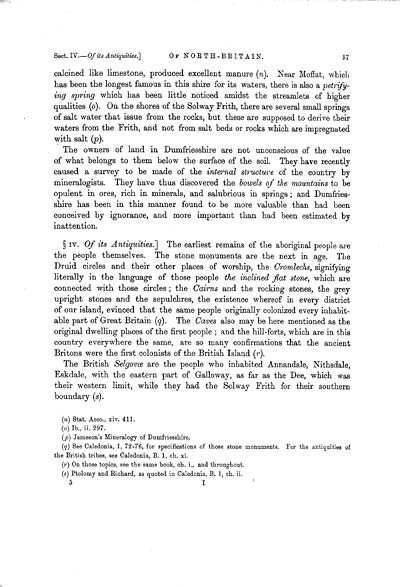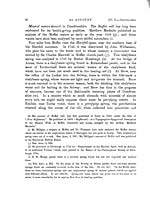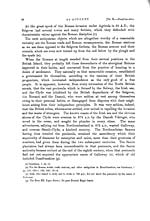Volume 5
(63) Page 57
Download files
Individual page:
Thumbnail gallery: Grid view | List view

57 calcined like limestone, produced excellent manure (n). Near Moffat, which has been the longest famous in this shire for its waters, there is also a petrify- ing spring which has been little noticed amidst the streamlets of higher qualities (o). On the shores of the Solway Frith, there are several small springs of salt water that issue from the rocks, but these are supposed to derive their waters from the Frith, and not from salt beds or rocks which are impregnated with salt (p). The owners of land in Dumfriesshire are not unconscious of the value of what belongs to them below the surface of the soil. They have recently caused a survey to be made of the internal structure of the country by mineralogists. They have thus discovered the bowels of the mountains to be opulent in ores, rich in minerals, and salubrious in springs; and Dumfries- shire has been in this manner found to be more valuable than had been conceived by ignorance, and more important than had been estimated by inattention. � IV. Of its Antiquities.] The earliest remains of the aboriginal people are the people themselves. The stone monuments are the next in age. The Druid circles and their other places of worship, the Cromlechs, signifying literally in the language of those people the inclined flat stone, which are connected with those circles; the Cairns and the rocking stones, the grey upright stones and the sepulchres, the existence whereof in every district of our island, evinced that the same people originally colonized every inhabit- able part of Great Britain (q). The Caves also may be here mentioned as the original dwelling places of the first people ; and the hill-forts, which are in this country everywhere the same, are so many confirmations that the ancient Britons were the first colonists of the British Island (r). The British Selgovce are the people who inhabited Annandale, Nithsdale, Eskdale, with the eastern part of Galloway, as far as the Dee, which was their western limit, while they had the Solway Frith for their southern boundary (s). (n) Stat. Acco., xiv. 411. (o) Ib., ii. 297. (p) Jameson's Mineralogy of Dumfriesshire. (q) See Caledonia, 1, 72-76, for specifications of those stone monuments. For the antiquities of the British tribes, see Caledonia, B. 1, ch. xi. (r) On those topics, see the same book, ch. i., and throughout. (s) Ptolomy and Richard, as quoted in Caledonia, B. 1, ch. ii. 5 I
Set display mode to:
![]() Universal Viewer |
Universal Viewer | ![]() Mirador |
Large image | Transcription
Mirador |
Large image | Transcription
Images and transcriptions on this page, including medium image downloads, may be used under the Creative Commons Attribution 4.0 International Licence unless otherwise stated. ![]()
| Caledonia, or, An account, historical and topographic of North Britain from the most ancient to the present times > Volume 5 > (63) Page 57 |
|---|
| Permanent URL | https://digital.nls.uk/74530250 |
|---|---|
| Description | Of its antiquities |
| Description | Vol. V. |
|---|---|
| Attribution and copyright: |
|

